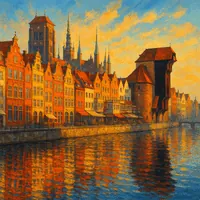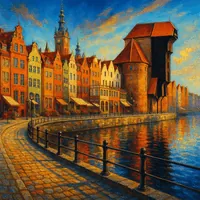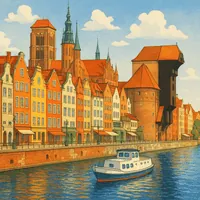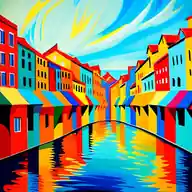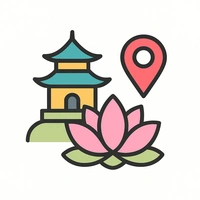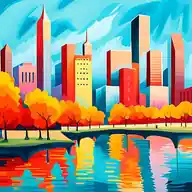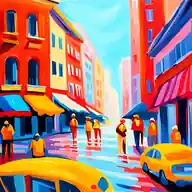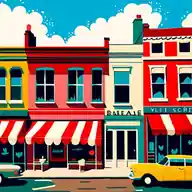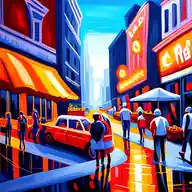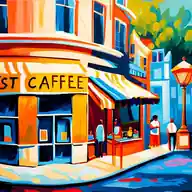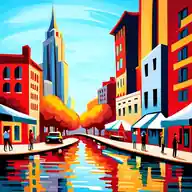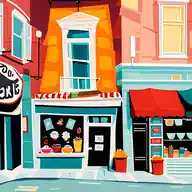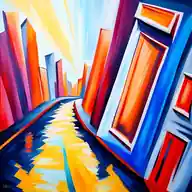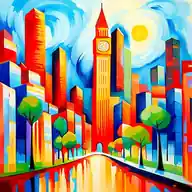Gdańsk, nestled along Poland's Baltic coast, is a city with a profound maritime legacy that sets it apart. Known for its pivotal role in the Hanseatic League, Gdańsk boasts the world's largest brick church, St. Mary's, a testament to its architectural splendor. The city's historic shipyards were the birthplace of the Solidarity movement, which spearheaded the fall of communism in Eastern Europe. Its amber-infused heritage is celebrated in the captivating Amber Museum, showcasing treasures unique to its Baltic shores.

Destinations

Travel Tips & Planning

General City Overview
Notable points about Gdańsk
- Historical Significance: Gdańsk is known for its pivotal role in world history, notably as the location where World War II began with the invasion of Poland by Germany in 1939. The city also played a significant part in the fall of communism in Eastern Europe as the birthplace of the Solidarity movement led by Lech Wałęsa.
- Unique Architecture: Gdańsk offers a distinct architectural style characterized by its colorful facades, intricate gables, and medieval structures. The Long Market (Długi Targ) with the historic Artus Court and the iconic Neptune Fountain are must-see landmarks.
- Maritime Heritage: As a crucial port city on the Baltic Sea, Gdańsk boasts a rich maritime history. The city's Maritime Museum and historic shipyards provide insights into its shipbuilding legacy, appealing to those interested in naval history and industry.
- Amber Capital: Known as the world's amber capital, Gdańsk is famous for its exquisite amber jewelry and crafts. The city offers numerous amber shops and even an Amber Museum, attracting those interested in unique, locally-crafted goods.
- Cultural Events: For arts and culture enthusiasts, Gdańsk hosts various festivals, such as the annual St. Dominic's Fair, one of the oldest and largest trade and cultural events in Europe, providing a vibrant experience of local culture and traditions.
- Romantic Getaway: Couples will find the picturesque streets, scenic Motława River, and charming cafes of Gdańsk perfect for a romantic escape. The city’s romantic ambiance is further enhanced by sunset views at the Gdańsk Moltawa.
- Family-Friendly Attractions: Families can enjoy the Hevelianum in Góra Gradowa, an interactive science center offering engaging exhibits, as well as the nearby Zoo in Oliwa and beautiful sandy beaches offering entertainment for children.
- Vibrant Nightlife: Singles and those looking for a lively night out will appreciate Gdańsk's bustling nightlife scene. The city offers a range of trendy bars, clubs, and live music venues where visitors can mingle and enjoy the local atmosphere.
- Educational Hub: Older visitors and lifelong learners will appreciate Gdańsk’s museums and historical sites. The European Solidarity Centre provides in-depth exhibitions on the city's role in the Solidarity movement, offering insight into contemporary history.
- Distinctive Fusion: Unlike other Polish cities, Gdańsk presents a unique juxtaposition of Polish and German cultural influences, stemming from its history as a free city and a member of the Hanseatic League, offering a cultural experience distinct from other regions in Poland.
Summarized User Reviews
Walking along the Motława River at dusk felt like stepping into a painting. Street musicians, glowing lanterns, and the smell of pierogi—magic.
Loved the history, but it was hard to find a quiet spot in peak season. Dluga Street gets crowded fast—bring patience!
St. Mary's Church was a jaw-dropper. Climbing that tower nearly killed me, but the city view made it worth every breath.
Weather was a gamble—sunny one minute, freezing wind the next. Not ideal beach vibes unless you're a Baltic veteran.
The mix of Polish pride and maritime soul in Gdańsk is unforgettable. And the amber jewelry? I couldn’t leave without it.
Interactive Word Cloud for Gdańsk

